
- ELEMENTARY TEACHING , MATH

Open Ended Math Questions and Problems for Elementary Students
Does your current math instruction involve only situations where there is one answer? Are students expected to solve problems following rigid procedures that do not require critical or creative thinking? These components are important; however, it’s time to take your math instruction to the next level! The answer: open ended math questions!
Open ended math questions, also known as open ended math problems, help learners grow into true mathematicians who use diverse problem solving strategies to explore mathematical situations where there isn’t necessarily one “right” answer. It equips them with the critical thinking skills they need to solve real world problems in the twenty-first century.
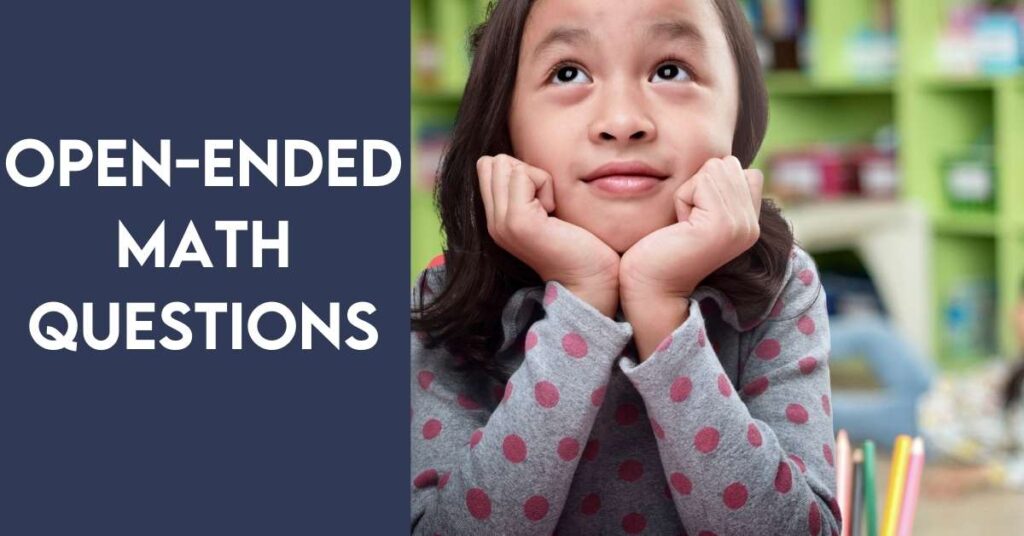
This blog post will answer the following questions:
- What is an open ended math question?
- What are the differences between open-ended and closed-ended problems in math?
- Why should I implement open ended questions in my classroom?
- What are the disadvantages of using open-ended math problems?
- How do I implement open ended math questions in my classroom?
- How do I create open ended math questions?
- What are some examples of open ended math problems?
- How do I grade open ended math tasks?

What is an Open Ended Math Question?
An open ended math question (which is known as an open ended math problem or open ended math task) is a real world math situation presented to students in a word problem format where there is more than one solution, approach, and representation. This instructional strategy is more than reciting a fact or repeating a procedure. It requires students to apply what they have learned while using their problem solving, reasoning, critical thinking, and communication skills to solve a given problem.
This strategy naturally allows for differentiation because of its open-ended nature. In addition, it is a valuable formative assessment tool that allows teachers to assess accuracy in computation and abilities to think of and flexibly apply more than one strategy. In addition to the teacher being able to learn about their students from this tool, the students can thoughtfully extend their learning and reflect on their own thinking through whole group discussions or partner talks.
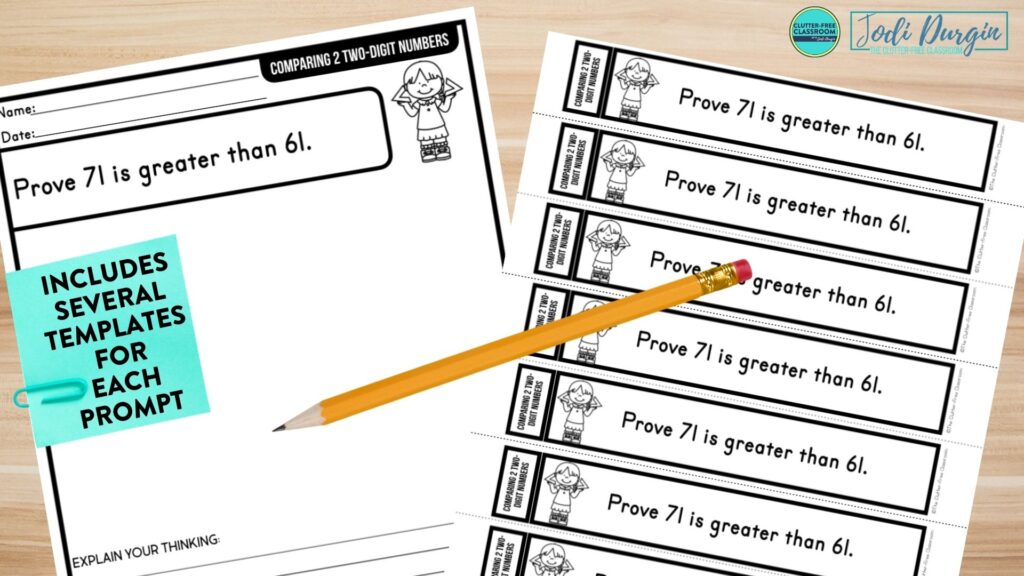
What are the Differences Between Open-Ended and Closed-Ended Problems in Math?
The major difference between open-ended math problems and closed-ended math problems is that close-ended ones have one answer and open-ended ones have more than one answer. This simple difference creates a very different learning experience for elementary students when they work on solving the problem.

What are the Advantages and Disadvantages of Open Ended Math Problems?
Advantages of open ended math problems.
There are many benefits to using open ended math questions in your classroom. This list of advantages of open ended questions will help you understand their ability to transform your math block! Here are 8 advantages to using open ended math tasks:
- Provides valuable and specific information to the teacher about student understanding and application of learning
- Allows the teacher to assess accuracy in computation and abilities to think of and flexibly apply more than one strategy
- Permits the teacher to see flexibility in student thinking
- Gives students the opportunity to practice and fine tune their problems solving, reasoning, critical thinking, and communication skills
- Creates opportunities for real-world application of math
- Empowers students to extend their learning and reflect on their thinking
- Fosters creativity, collaboration, and engagement in students
- Facilitates a differentiated learning experience where all students can access the task

Disadvantages of Open Ended Math Problems
Although there are tons of benefits to using open ended math problems in your classroom, it is important to note that there are some disadvantages. Here are 3 disadvantages using open ended math tasks:
- Increases time in collecting data
- Provides a higher complexity of data
- Requires the implementation and practice of routines
3 Ways to Implement Open Ended Problems During Your Math Block
Here are 3 ways you can implement open ended problems in your elementary classroom:
- Start a lesson with an open-ended math problems for students to solve independently. Invite them to share their work and reasoning with a partner. Ask a few students to share their ideas with the whole class.
- Use the open-ended math problems for fast finishers . If a student or a group of students tend to finish independent work before the rest of the class, invite them to work on an open-ended math problem.
- Utilize open-ended math problems as a center during math workshop . You will not have to worry about students finishing that math center before it is time to switch to the next center.

3 Ways to Write Open Ended Math Questions with Examples
Here are 3 ways to create open ended math questions accompanied with easy-to-understand open ended math problems examples:
- Start with a Closed-Ended Question. For example, a closed-ended question could be: What is the sum of 10 plus 10? The related open-ended question would be: The sum is 20. What could the addends be? There are an infinite number of responses because students could use negative numbers.
- Ask Students to Explain, Prove, or Justify their Thinking. An example of this is, “Prove 5 + 6 = 11.” One possible student response could be that they know the sum is 11 because of the doubles + 1 rule. Another student may take out counters, while another draws a picture.
- Invite Students to Compare 2 Concepts. For example, ask students to identify the similarities and differences between 2D and 3D shapes. Some possible responses for similarities are that they are both geometry concepts and classifications of shapes. A difference they could say is that 2D shapes are flat, while a 3D shape is solid.
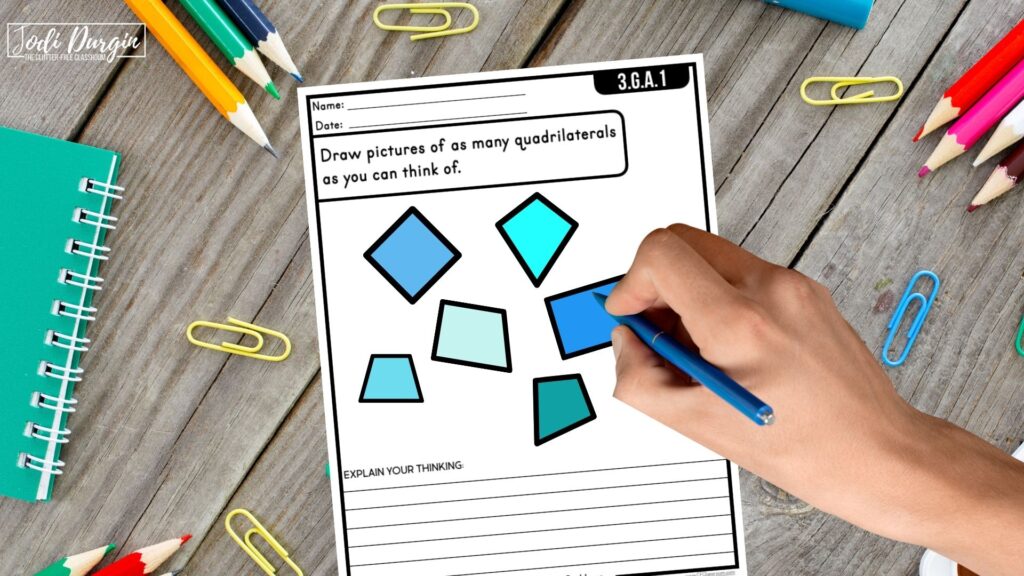
How do you Grade Open-Ended Math Questions?
Grading open-ended math tasks is not as clear cut as closed-ended questions. If you are using the task as a formative assessment for your own planning purposes, then you have flexibility on how you choose to evaluate students’ work. However, I recommend you use a rubric if you plan to use it as a summative assessment. Remember to share the rubric with students so that the expectations are clear.
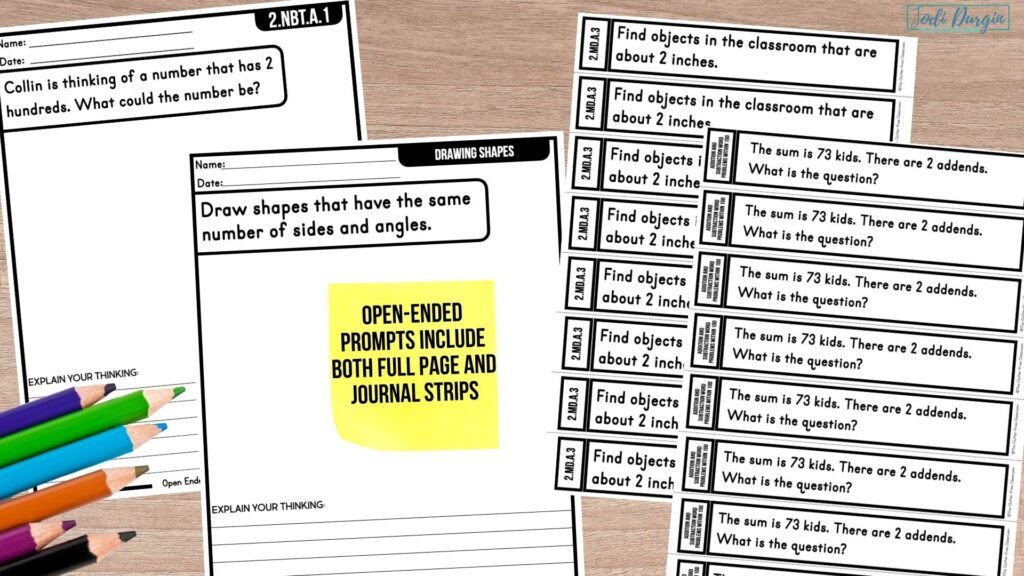
Get Our Open-Ended Math Prompts
Math resources for 1st-5th grade teachers.
If you need printable and digital math resources for your classroom, then check out my time and money-saving math collections below!
Try a Collection of our Math Resources for Free!
We would love for you to try these open ended question resources with your students. They offer students daily opportunities to practice solving open ended problems. You can download worksheets specific to your grade level (along with lots of other math freebies) in our free printable math resources bundle using this link: free printable math worksheets for elementary teachers .
Check out my daily open ended problem resources !
- 1st Grade Open Ended Math Question Problems
- 2nd Grade Open Ended Math Question Problems
- 3rd Grade Open Ended Math Question Problems

You might also like...
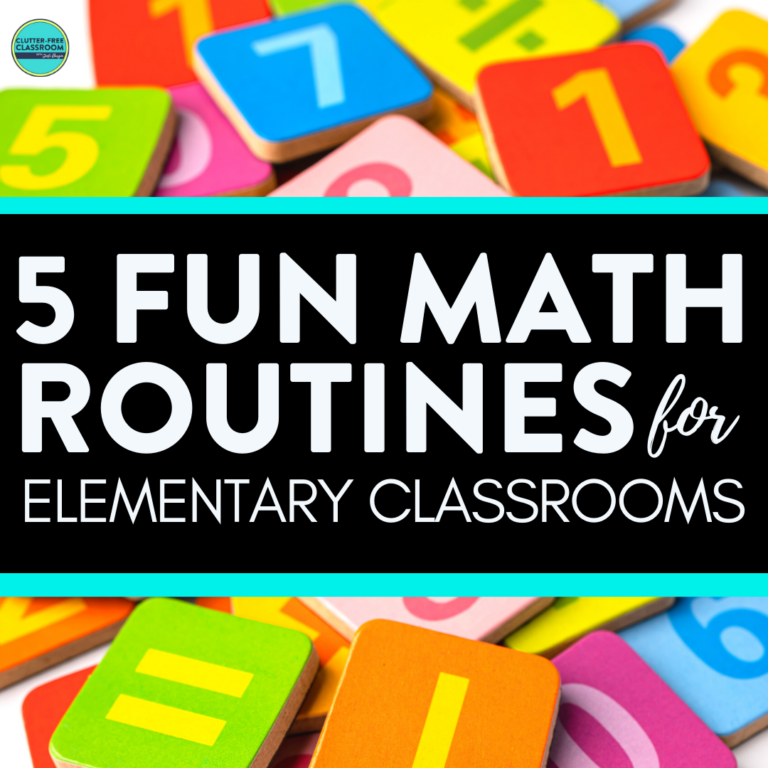
5 Fun Math Routine Ideas for Elementary Teachers
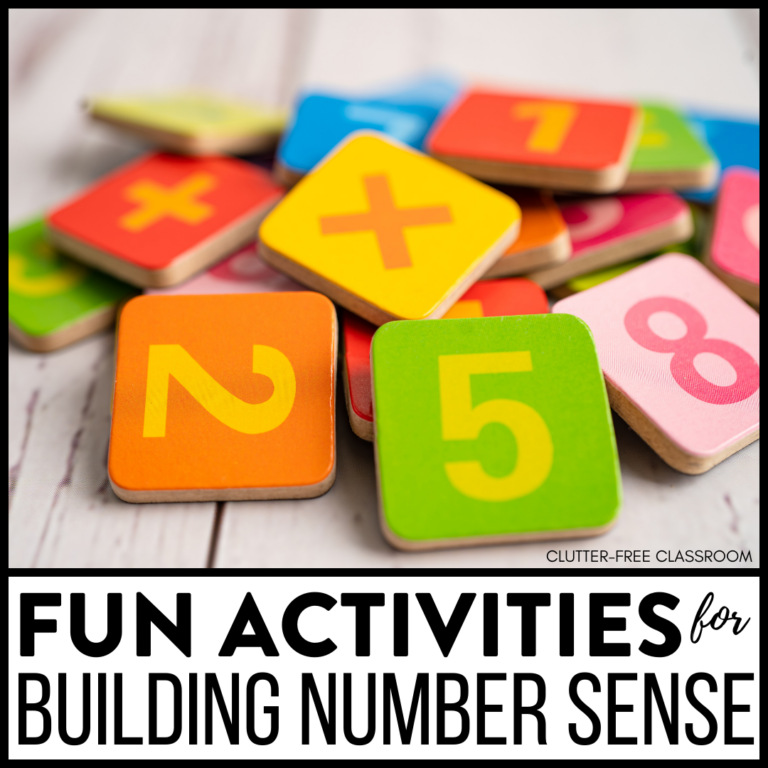
Using Number of the Day Activities for Teaching Number Sense in 2024
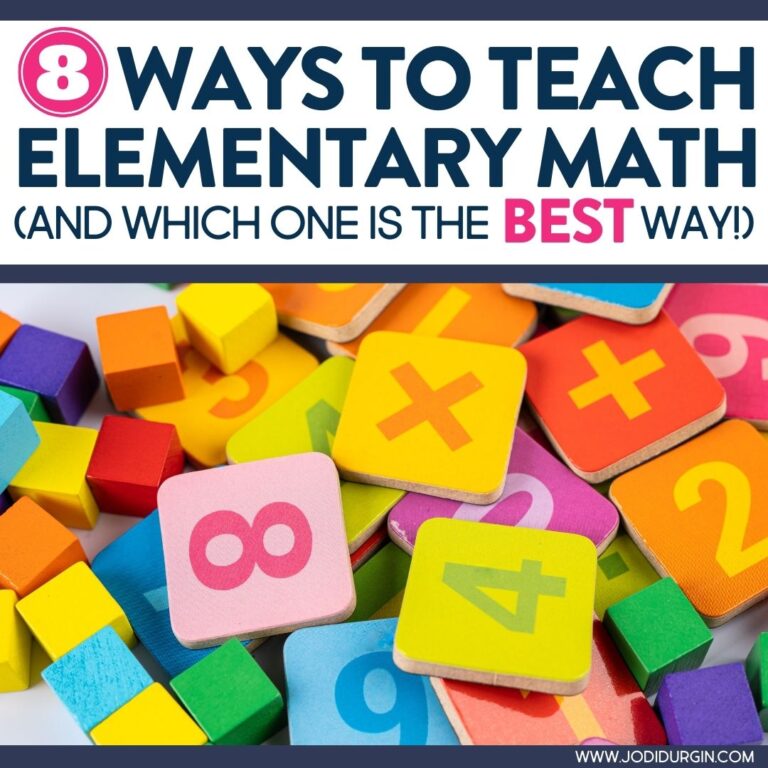
8 Types of Instructional Strategies for Teaching Math (Grades 1-5) in 2024
Join the newsletter.

- CLUTTER-FREE TEACHER CLUB
- FACEBOOK GROUPS
- EMAIL COMMUNITY
- OUR TEACHER STORE
- ALL-ACCESS MEMBERSHIPS
- OUR TPT SHOP
- JODI & COMPANY
- TERMS OF USE
- Privacy Policy
Get a collection of FREE MATH RESOURCES for your grade level!
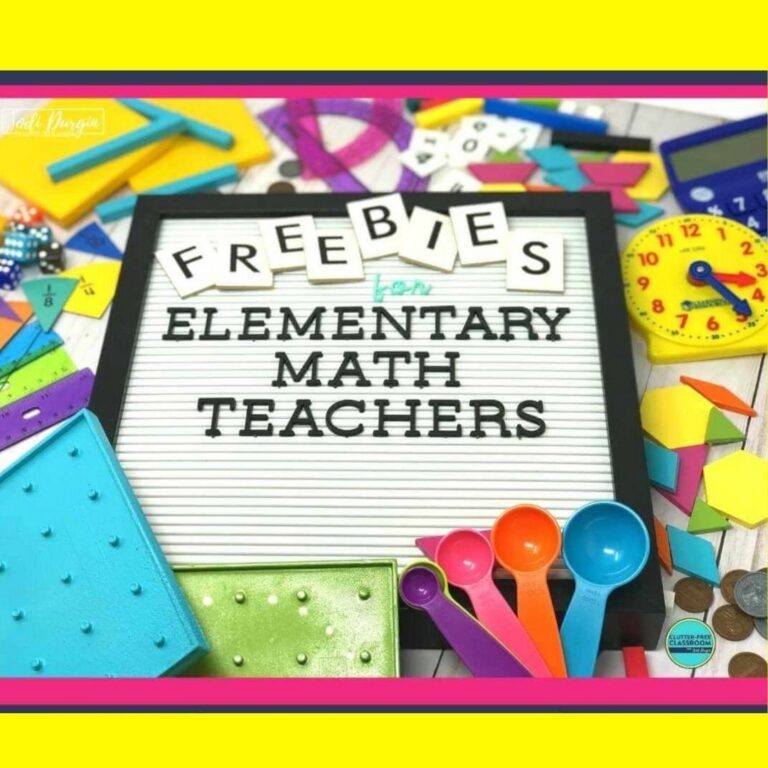
Check Out These Free Courses & Discounts >

Opening Minds with Open-Ended Math Problems in the Primary Classroom
by Model Teaching | December 21, 2018.
Wait, so, what is the RIGHT answer?” “Sarah got a different answer than I did…how can we BOTH be right?” You will most likely hear all kinds of responses like this when you start to incorporate open-ended math activities into your classroom. At first, they’ll probably make your students look at you as if you have two heads. But, these kinds of reactions will begin to subside once your students have been exposed to the idea that there are many ways to solve problems, even math problems! Encouraging this kind of “endless possibility” thinking is an effective way to teach your students to challenge themselves and think outside of the “normal” problem solving thinking.

What are open-ended math problems?
Open-ended math problems are problems that have more than one possible answer. These problems might present an end result and then ask students to work backward to figure out how that end result might have been achieved or they might ask students to compare two concepts that can be compared in a variety of different ways. But whatever way they are presented, the purpose of open-ended math problems is always to encourage students to use higher order thinking skills to solve problems and understand that some problems can be solved in many ways, with many outcomes.
Examples of Open-ended Math Problems
If you teach pre-k or kindergarten, an open-ended math problem might be: “You have 2 shapes that have a different amount of sides. What 2 shapes could you have? Show and name the shapes.” You would provide them with crayons, paper, pattern blocks, or whatever other manipulative they might be used to using when discussing shapes and students would use these manipulatives to come up with as many answers as they can. Your little ones may answer with a variety of answers based on their current skill level. You may get answers like “triangle and square”, “hexagon and parallelogram”, or “a circle is a shape” depending on what each student knows about shapes. This is a great way to reinforce what students already know and to quickly assess where they are in their knowledge.
If you teach first grade, an open-ended math problem might be: “I’m thinking of the number 8. What two numbers work could work together to make the number 8?” Again, you would provide them with manipulatives they normally use for composing and decomposing numbers, like counters, small erasers, counting bears, unifix cubes, or even playdoh balls. The extra bonus about this kind of problem is that it’s extremely easy for students to show their math skills. Some might use addition, others will use subtraction, and you may even run into a kiddo or two who can use multiplication to find the number. However students choose to explore all the possibilities for answers, be sure to give them a few options for how to show their thinking. This might include simply writing equations, drawing pictures with the equations, or even building the number with a manipulative and then taking a picture of it with an iPad.
As students get older and move onto more abstract thinking in second and third grade, you might incorporate more word problems like: “The difference between the temperature on Monday and Tuesday was 13 degrees. What could the temperature have been on each day? Find and explain at least 5 different answers.” Or “Penelope sees 37 children playing in a corn maze. If those children split into four groups, how many children could be in each group? Find and explain at least 5 different answers.” As always, be sure to provide students with manipulatives, paper and pencils, dry erase markers and whiteboards, or whatever you normally use to help them solve problems and then let them go to work! By presenting these kinds of word problems, you’ll expose students to a variety of math concepts (such as division in this example) just by allowing them to think about how to solve the problem on their own. Then, when these concepts are formally introduced, they will hopefully feel more familiar to some students.
Why should I use open-ended math problems with my students?
There are many benefits to incorporating these kinds of problems into your students’ daily routine, but here are a few of the most obvious and effective ones:
- Open-ended problems encourage higher order thinking skills. Students will not only be “recognizing”, “identifying”, or “describing” their thinking; they’ll be “justifying”, “defending”, and “evaluating” their problem solving skills and how they arrived at their answers.
- Open-ended problems build confidence in your students. Once students recognize that there are many possibilities for correct answers and thinking, they begin to participate more readily because they can bring to the table. Students who normally struggle with math might solve the problem on a very basic level, using a basic strategy, but they’ll be correct! And your advanced students can solve it on their advanced level and be just as correct as the student who struggles. Simply knowing that the way that they specifically thought and solved the problem was considered correct builds confidence for students.
- Open-ended problems are engaging! Students are immediately engaged in these kinds of problems because they recognize that there are so many different ways to solve it. Whether students are working in small groups or independently, there is possibility for so many different ideas and answers to be correct that everyone wants in on it. This engagement, in turn, encourages collaboration among students and soon, they’re sharing their thinking and learning from each other to solve problems.
- Open-ended problems encourage creativity. Students are capable of using so many strategies that they’ve learned over the years to solve problems and, given the space and time, they can even come up with some of their own strategies for solving problems. Open-ended problems give students permission to be creative in their thinking and problem solving.
- Open-ended problems make it easy for teachers to see what levels students are working at. Simply by walking around the room while students are working to solve an open-ended math problem, you’ll be able to informally assess what kind of level they are independently working on. This can be extremely beneficial as you are collecting data, forming groups, or simply getting a feel for what kind of skills each student is working with.
For more information about the benefits of using open-ended math problems, read:
https://nzmaths.co.nz/benefits-problem-solving
How do I incorporate open-ended math problems into my math instructional time?
Some of the simplest ways to incorporate open-ended math problems into your math instructional time is to include them in math stations, use them in small groups, and use them as a warm up.
- Math Stations: You can implement open-ended problems into your math stations a number of ways, including thinking mats, task cards, or interactive math journals. The simplest way to implement them into your math stations is by using task cards. Task cards are pre-made cards that you can create or purchase to cut and laminate for students to use repeatedly. Task cards usually include words, pictures, diagrams, or a combination of all to present a problem to students. To use task cards in a math station, simply create or purchase the cards you want with open-ended word problems or picture problems. Then, simply print them out and cut/laminate them to make them durable and easily reused. (TEACHER TIP: Most dry erase markers wipe off of lamination pretty easily if it’s wiped off within a reasonable amount of time. Your students may want to mark the important parts of the problem on the actual task card with dry erase marker if you want them to. Just wipe if off after use!) I would suggest storing cards in a labeled plastic container or ziplock bag to keep them organized. It is suggested that you always allow students to use manipulatives as needed, as this can help students feel allowed to express their creative problem-solving thoughts. So, be sure your task card station provides anything students might use to solve problems in their own way: whiteboards, markers, papers, crayons, counters, manipulatives, thinking mats, laminated task cards, etc. For example, if you give students a task card with this problem on it: “Marcy finds 47 apples on the ground. What 3 addends could create this sum? Find and explain at least 5 answers.”, I would provide them with small apple erasers or counters, a whiteboard and dry erase marker, and an iPad to take picture evidence of their five (or more!) answers when they’re finished. Please refer to pages 10-16 in the resource provided to you below this article for some sample open-ended word problem task cards that you can use with your students immediately!
- Small Groups: To implement open-ended problems in your small groups, using thinking mats, manipulatives, and prepared open-ended problems is a great way to ease students into working on open-ended problems independently. This is a great way to model your own thinking and problem-solving to allow students to see how they can begin their own ways of solving the problems. Take a moment to download and look at the thinking mat activity in the downloadable resource below. You can incorporate these mats into your small group activity by providing each student with a laminated copy of the mat you want to use and manipulatives for them to work with to follow the mat’s directions. For example, the thinking mat that says “Make patterns out of these shapes and name them.” would be an excellent open-ended activity for a group of kindergartners who are working on shapes OR patterns. Give each student a few of each of the pattern blocks shown on the mat and a dry erase marker. Explain and model how YOU would complete the activity by creating a pattern with the pattern blocks, tracing the blocks or drawing your pattern, and then naming it with letters (ie.: rhombus, rhombus, circle would be named an AAB pattern). This will give your students an idea of what’s expected and their little brains can get started coming up with their own patterns!
- Warm Up: Using your warm-up time to practice with open-ended problems is a great way to model your own thinking to the whole. Modeling how to solve these problems step-by-step along with the whole class can help give reluctant participants the courage and understanding to participate and ready participants the reassurance that they’re on the right track. As an example, look at “Activity 3: Creating and Solving Problems” in the downloadable resource. You will notice a few thinking mats included, along with cards that correspond to the mats. For a warm-up activity before you begin your lesson for the day, you could give each student a laminated thinking mat and a corresponding manipulative (like, pass out the table and basket cards and give every student some small apple erasers). Then, project a corresponding task card so that everyone can see it. Read the card together, model one way you could solve the problem using your own thinking mat and manipulatives, and then allow students to solve it their own way to find one or two other answers. I would ask students to record their thinking and answers in a math journal or something similar so I could look back on their skills from early in the year and compare them to the end of the year. This is a quick, great way to collect data on student’s skills without a lot of involvement from you!
These are just a few ways to incorporate open-ended problems into your math time. I encourage you to try one way for a week or two and then experiment with another way once your students are showing they feel confident in the first implementation.
How do I make sure to provide students with open ended math problems during math each day?
In order to provide your students with activities and resources that encourage deep thinking and allow every student to participate, detailed planning is required. Deciding what standards and concept you want to focus on and choosing the best way to practice skills related to that concept before having students complete an activity is crucial to creating an effective learning time. If you peek at page 37 of the resource below, you’ll see a planning page that you can use to plan out the open-ended activities you want to use in your classroom. By editing this page with your own information, you can plan for a week of open-ended activities quickly and efficiently. This is also a great way to hold yourself accountable for how often you’re giving your students the opportunity to work on open-ended activities.
Any way you choose to implement open-ended problems in your classroom, your students are sure to grow in their problem-solving abilities and confidence. Creating a space that is safe for your students to take chances and risks with their learning is one of the greatest gifts you can give them. By incorporating ways for your students to express their individual ways of thinking, like open-ended math problems, you’ll foster a love of creative thinking and confidence in problem-solving skills.
Notes About the Included Resources:
The resources included in this blog post are for you to use in your classroom with your students. More detailed explanations for how to incorporate the activities are included in the resources themselves. There are also a few blank templates within the resource so that you can create your own task cards, thinking mats, and activity plans.

Related Professional Development Courses:
Math Stations for PreK-2nd Grade
Efficient Classroom Processes
Inquiry-Based Learning: Using Inquiry as a Teaching Strategy
(10 PD Hours) Explore the strategies involved in planning and executing inquiry-based lesson plans. The components of an inquiry-led lesson will be outlined and discussed, and participants will learn to develop and plan an inquiry-led lesson.
Project Based Learning
(22 PD Hours) This course gives participants a thorough understanding of Project-Based Learning, including the critical components, as well as common misconceptions. Throughout the course, participants will design their own cycle of PBL they can immediately implement in their own classroom.
All Blog Topics
Classroom Management
- English Language Learners (ELL)
Gifted & Talented
Leadership Development
Lesson & Curriculum Planning
Math Instruction
Parent Involvement
Reading/ELA Instruction
Science Instruction
Social/Emotional Learning
Special Education
Teaching Strategies
Technology In The Classroom
Testing Strategies & Prep
Writing Instruction
DOWNLOADS & RESOURCES

Open Ended Math Activities for the Primary Classroom
Use these templates and graphic organizers for students who may need additional support. Feel free to download and modify the editable version, including the Frayer model template and word bank template.
IMPLEMENTATION GOAL
Choose or create an open-ended math activity to incorporate into your math instructional time. Plan to introduce the activity to your students at the beginning of the week, model and practice how to complete the activity together, and then allow them to work on the activity for 10-15 minutes per day throughout the rest of the week. Take anecdotal notes about growth you notice and how your students react to these kinds of problems. Do they enjoy them? Dread them? Are you seeing improvement in their thinking and willingness to participate? Take note of these kinds of things as the week goes on. Then, decide what open-ended problems you’ll implement the following week.
- What is Open-Ended Problem Solving? – https://mste.illinois.edu/users/aki/open_ended/WhatIsOpen-ended.html
- The Effect of Open-ended Tasks- http://journals.yu.edu.jo/jjes/Issues/2013/Vol9No3/8.pdf
- Clip art generated by Creative Clips Clipart by Krista Walden, http://www.teacherspayteachers/store/krista-walden
Share This Post With Friends or Colleagues!
Your shopping cart, the cart is empty, search our courses, blogs, resources, & articles.
Open-Ended Maths Problems Task Cards
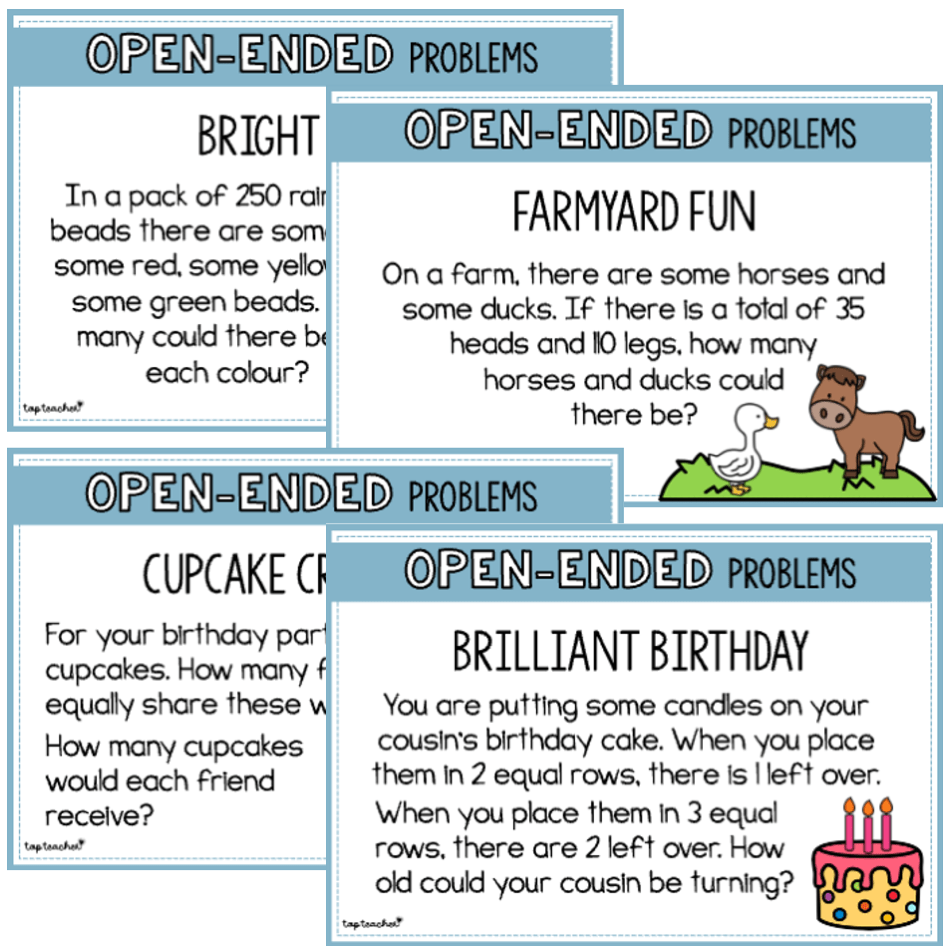
Worksheets & Templates
Add to calendar
Add to favourites, description.
Are you looking to extend your students’ mathematical thinking? Are you seeking ways to apply maths concepts you have taught engagingly and authentically? Are you after easy yet effective ways to differentiate and assess mathematical understandings? If so, these open-ended maths task cards are the perfect resource for your class.
With 24 open-ended problems across a range of mathematics content areas, this set of cards challenges students to flexibly combine and apply a range of mathematical skills, with the opportunity to demonstrate multiple answers.
These task cards can be used for independent or guided practice. Selected cards can be used as formative assessment tools within focused units, or the set can be used throughout the year to continue to consolidate prior learning, regardless of your classroom’s current topic.
Designed with four problems per page and with the option of colour or black and white cards, simply print, cut and distribute to students. (They can also be laminated to be used again and again with different students).
Ensure your students get the most out of these challenges and know how to show their best thinking with our Solving Open-Ended Problems PowerPoint. Or you can have all the open-ended challenges in one place in our Open-Ended Maths Problems Booklet.
Additional information
Related products.
- Sustainable Practices Brochure
- Safe Adults, Safe Places Colouring Sheet
- Health Assessment Years 1 & 2: Protective Behaviours & Help Seeking Strategies
- Lunchbox Design Challenge
- Years 1 & 2 Making Healthy & Safe Choices Display PACKAGE
- Partitioning 10 & Teen Numbers
Australian Curriculum V9
Lorem ipsum dolor sit amet, consectetur adipiscing elit.
Lorem ipsum/ Lorem ipsum/ Lorem ipsum
Email Address
Remember Me
Out of Credits
Looks like you’re out of credits.
Create an account
Reset password, item added to your cart.
0 items in the cart ( $ 0.00 )
Popular searches in the last week:
Problem-solving maths investigations for year 3.
Hamilton provide an extensive suite of problem-solving maths investigations for Year 3 to facilitate mathematical confidence, investigative inquiry and the development of maths meta skills in 'low floor – high ceiling' activities for all.
Explore all our in-depth problem solving investigations for Year 3 .
Use problem-solving investigations within every unit to encourage children to develop and exercise their ability to reason mathematically and think creatively.
Investigations provide challenges that offer opportunities for the development of the key mathematical skills while deepening conceptual understanding. They are designed to be accessible in different ways to all children. An added bonus is the substantial amount of extra calculation practice they often incorporate! The problems are designed to help children identify patterns, to explore lines of thinking and to reason and communicate about properties of numbers, shapes and measures.
Hamilton provide a mix of our own specially commissioned investigations, that include guidance for teachers together with a child-friendly sheet to guide your pupils through the investigation, as well as links to investigations on other highly regarded websites.
I am very grateful for Hamilton Trust resources, particularly the maths investigations. Julia, teacher in Wiltshire

You can find Hamilton's investigations for Year 3:
- Individually, they are incorporated into every unit in our Year 3 flexible maths blocks .
- Collectively, they appear on our resources page where you can explore all our in-depth problem solving investigations for Year 3 .
Do read our extensive range of advice for more information about the investigations and for tips on how to use them effectively.
Hamilton’s problem-solving investigations are 'low floor, high ceiling' activities that give all children opportunities to develop mastery and mathematical meta-skills. Explore a set for a whole year group.
Hamilton’s Problem-solving Investigations provide school-wide solutions to the challenges of building investigative skills from Early Years to Year 6.
This site uses cookies to give you the most relevant information. Learn more
Log in or sign up to get access to this resource
School subscription, reduce teacher workload.
From £155 (+ VAT) per year. Access to all key stages for multiple users.
Individual Subscription
For inspirational teaching.
Just £45 (£37.50 + VAT) per year to get access to all resources.
Early Career Teacher
Develop your teaching.
Just £33 (£27.50 + VAT) to get access to all resources for 2 years.
Taster Account
100s of resources.
Register to access all free resources.
Already subscribed?
Log in to get access.
Reasoning/Problem Solving Maths Worksheets for Year 3 (age 7-8)
Money problems and challenges.
A variety of problem solving activities involving money.

50p to spend, but can you make sure you get the correct change?

Watch out when writing pence as pounds and remember to always have two digits after the decimal point.
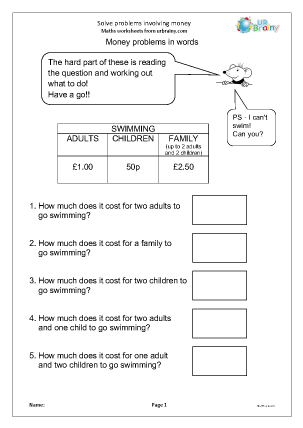
The hardest part of these money problems is to read the question and work out what to do.
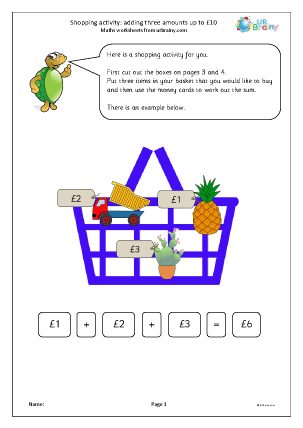
Put three items in your basket that you would like to buy and then use the money cards to work out the sum.
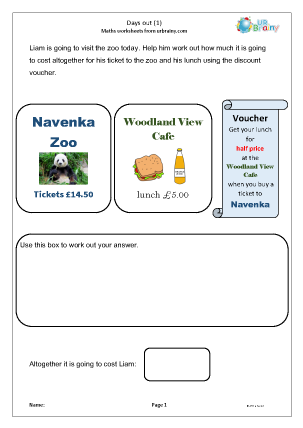
Solve money problems using the information provided.
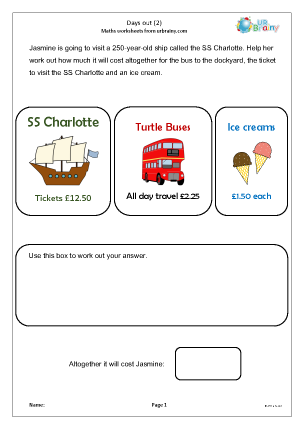
Solve money problems at the skating rink.

Plenty of monkey business here!

It's a trip to the zoo to find the very best value.
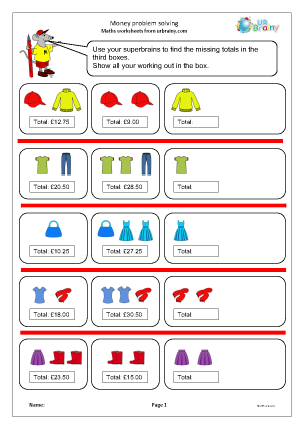
Some tricky money problems to solve.
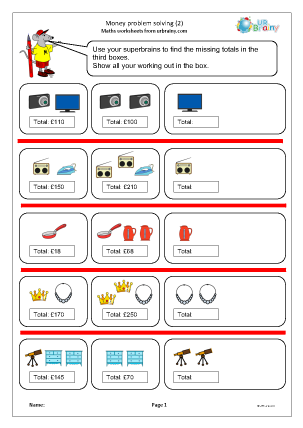
More tricky money problems to solve.

Finding different amounts from a given set of coins.
Number and calculating problems
Solve number problems and calculating using addition, subtraction, multiplication and division.

Find the 2-digit numbers that can be made using these digit cards.
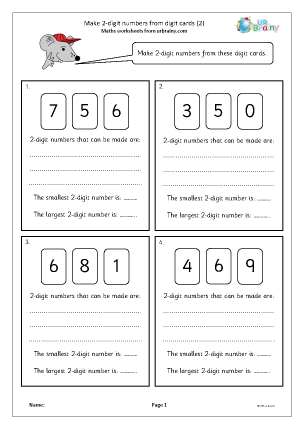
Make 2-digit numbers and find the smallest and largest numbers.

More on finding 2-digit numbers from three digit cards.

Tricky little problems involving monsters' legs.
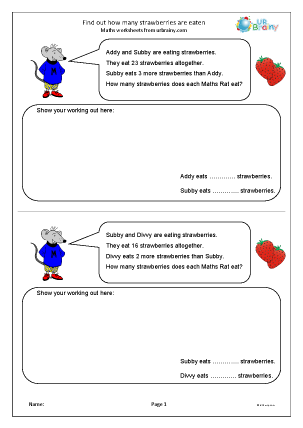
Use logic, addition and subtraction to find out how many strawberries are eaten.

Bar Model: addition and subtraction facts.

Use bar models to add and subtract.

Encourage children to make addition and subtraction come to life by writing short number stories.

What numbers can you make with digit cards?

What are the largest and smallest numbers that can be made with 3 cards?
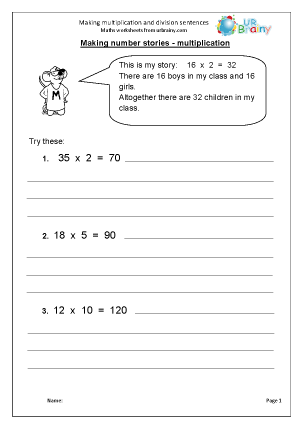
More number stories to write: this time all about multiplication and division.

All the numbers are here, but the signs are missing! Can you work out what the signs should be?

Investigating odd and even numbers and what happens when you add them together.

Use knowledge of place value to find all possible answers.

Finding the numbers and missing digits to make number sentences correct.

Investigate statements involving odd and even numbers.
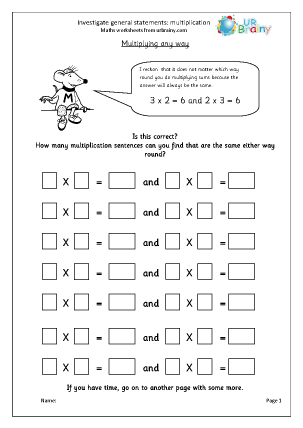
Investigate statements about multiplication and times tables.
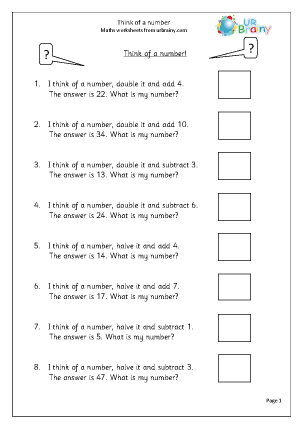
I?m good at thinking of numbers, but can you work out what number I am thinking about ? I do give a clue!

Work out the missing value using division and addition.

Use reasoning to find the missing values.

More on finding the missing values - an early introduction to algebra.
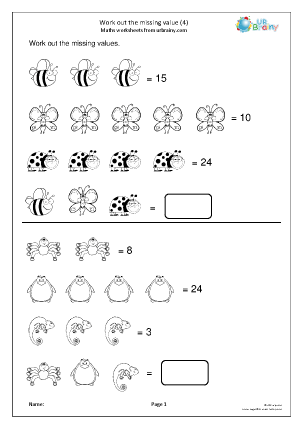
Use division and addition to find the missing values.

Find the missing values from the information given.

More on finding the value using reasoning.
Real life and word problems
A selection of real life problems and word problems.

Tricky word problems.

More tricky word problems.
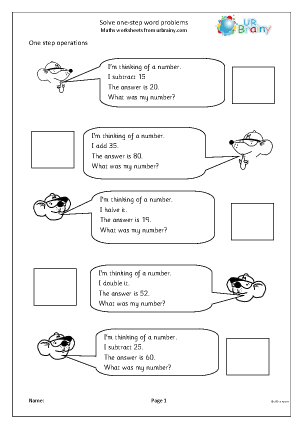
Tricky questions, but you only have to carry out one maths step to answer them.

Even trickier questions, and you have to carry out at least two steps to work them out!

More word problems, from the library to shopping and on to flying around the world.
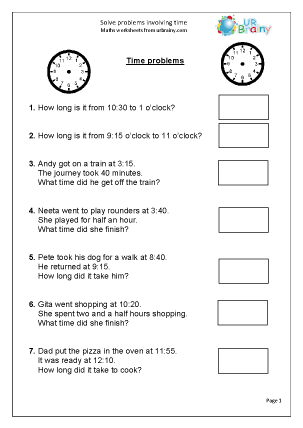
Here we have four pages of questions all on time, including a trip to Alicante!
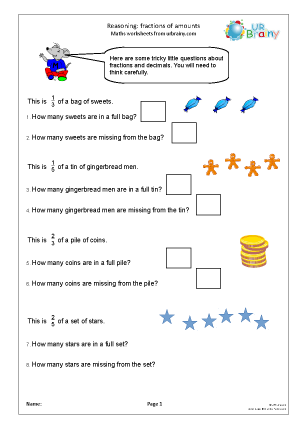
Solving tricky fraction problems.
More challenges and activities
A great selection of activities requiring logical thinking.
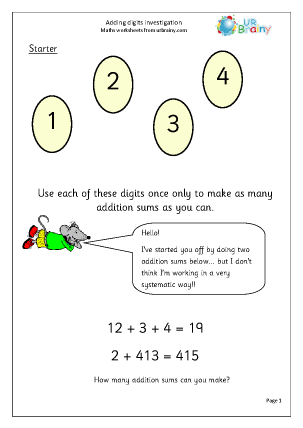
Investigation looking at possibilities when adding the digits from 1 to 5.
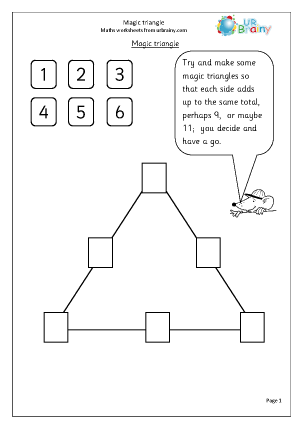
This time you can decide the total for the sides of the triangle.
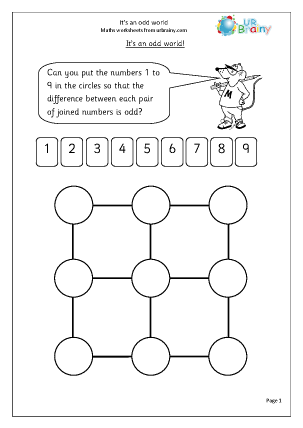
Can you put the numbers 1 to 9 in the diagram so that the difference between each pair of joined numbers is odd?

This challenge is to find as many ways as possible of making 12 using three number cards and the add, subtract and multiply signs.

A development of the 'Caterpillar investigation' but using multiples of 10. Great for practising addition.

3 dinosaurs laid some eggs. They laid 19 altogether. How many did they each lay?

How many ways can three runners cover a distance of 19 miles? They all have to run an odd number of miles.

A book challenge here. How accurately can you guess the number of pages in books?
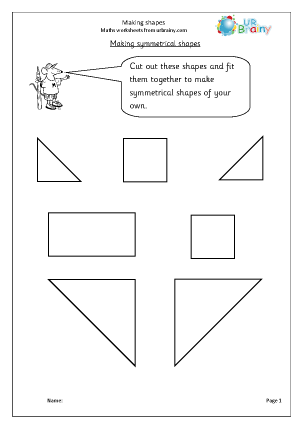
2D card shapes and a 3 x 3 pinboard are useful for these shape activities.

A calculator is needed to find how many different answers can be made from the numbers given. Good for working in an organised, logical way.
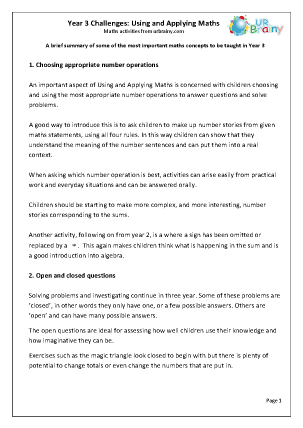
A brief summary of some of the most important maths concepts to be taught in Year 3 by way of challenges and investigations.
Subscribe to our newsletter
The latest news, articles, and resources, sent to your inbox weekly.
© Copyright 2011 - 2024 Route One Network Ltd. - URBrainy.com 5.1
- STEM Ambassadors
- School trusts
- ITE and governors
- Invest in schools
- STEM careers inspiration
- Benefits and impact
- Our supporters
- Become a STEM Ambassador
- Request a STEM Ambassador
- Employer information
- Training and support
- STEM Ambassadors Partners
- Working with community groups
- Search icon
- Join the STEM Community
Problem Solving
A selection of resources containing a wide range of open-ended tasks, practical tasks, investigations and real life problems, to support investigative work and problem solving in primary mathematics.
Problem Solving in Primary Maths - the Session
Quality Assured Category: Mathematics Publisher: Teachers TV
In this programme shows a group of four upper Key Stage Two children working on a challenging problem; looking at the interior and exterior angles of polygons and how they relate to the number of sides. The problem requires the children to listen to each other and to work together co-operatively. The two boys and two girls are closely observed as they consider how to tackle the problem, make mistakes, get stuck and arrive at the "eureka" moment. They organise the data they collect and are then able to spot patterns and relate them to the original problem to find a formula to work out the exterior angle of any polygon. At the end of the session the children report back to Mark, explaining how they arrived at the solution, an important part of the problem solving process.
In a second video two maths experts discuss some of the challenges of teaching problem solving. This includes how and at what stage to introduce problem solving strategies and the appropriate moment to intervene when children find tasks difficult. They also discuss how problem solving in the curriculum also helps to develop life skills.
Cards for Cubes: Problem Solving Activities for Young Children
Quality Assured Category: Mathematics Publisher: Claire Publications
This book provides a series of problem solving activities involving cubes. The tasks start simply and progress to more complicated activities so could be used for different ages within Key Stages One and Two depending on ability. The first task is a challenge to create a camel with 50 cubes that doesn't fall over. Different characters are introduced throughout the book and challenges set to create various animals, monsters and structures using different numbers of cubes. Problems are set to incorporate different areas of mathematical problem solving they are: using maths, number, algebra and measure.

Problem solving with EYFS, Key Stage One and Key Stage Two children
Quality Assured Category: Computing Publisher: Department for Education
These three resources, from the National Strategies, focus on solving problems.
Logic problems and puzzles identifies the strategies children may use and the learning approaches teachers can plan to teach problem solving. There are two lessons for each age group.
Finding all possibilities focuses on one particular strategy, finding all possibilities. Other resources that would enhance the problem solving process are listed, these include practical apparatus, the use of ICT and in particular Interactive Teaching Programs .
Finding rules and describing patterns focuses on problems that fall into the category 'patterns and relationships'. There are seven activities across the year groups. Each activity includes objectives, learning outcomes, resources, vocabulary and prior knowledge required. Each lesson is structured with a main teaching activity, drawing together and a plenary, including probing questions.

Primary mathematics classroom resources
Quality Assured Collection Category: Mathematics Publisher: Association of Teachers of Mathematics
This selection of 5 resources is a mixture of problem-solving tasks, open-ended tasks, games and puzzles designed to develop students' understanding and application of mathematics.
Thinking for Ourselves: These activities, from the Association of Teachers of Mathematics (ATM) publication 'Thinking for Ourselves’, provide a variety of contexts in which students are encouraged to think for themselves. Activity 1: In the bag – More or less requires students to record how many more or less cubes in total...
8 Days a Week: The resource consists of eight questions, one for each day of the week and one extra. The questions explore odd numbers, sequences, prime numbers, fractions, multiplication and division.
Number Picnic: The problems make ideal starter activities
Matchstick Problems: Contains two activities concentrating upon the process of counting and spotting patterns. Uses id eas about the properties of number and the use of knowledge and reasoning to work out the rules.
Colours: Use logic, thinking skills and organisational skills to decide which information is useful and which is irrelevant in order to find the solution.

GAIM Activities: Practical Problems
Quality Assured Category: Mathematics Publisher: Nelson Thornes
Designed for secondary learners, but could also be used to enrich the learning of upper primary children, looking for a challenge. These are open-ended tasks encourage children to apply and develop mathematical knowledge, skills and understanding and to integrate these in order to make decisions and draw conclusions.
Examples include:
*Every Second Counts - Using transport timetables, maps and knowledge of speeds to plan a route leading as far away from school as possible in one hour.
*Beach Guest House - Booking guests into appropriate rooms in a hotel.
*Cemetery Maths - Collecting relevant data from a visit to a local graveyard or a cemetery for testing a hypothesis.
*Design a Table - Involving diagrams, measurements, scale.

Go Further with Investigations
Quality Assured Category: Mathematics Publisher: Collins Educational
A collection of 40 investigations designed for use with the whole class or smaller groups. It is aimed at upper KS2 but some activities may be adapted for use with more able children in lower KS2. It covers different curriculum areas of mathematics.

Starting Investigations
The forty student investigations in this book are non-sequential and focus mainly on the mathematical topics of addition, subtraction, number, shape and colour patterns, and money.
The apparatus required for each investigation is given on the student sheets and generally include items such as dice, counters, number cards and rods. The sheets are written using as few words as possible in order to enable students to begin working with the minimum of reading.
NRICH Primary Activities
Explore the NRICH primary tasks which aim to enrich the mathematical experiences of all learners. Lots of whole class open ended investigations and problem solving tasks. These tasks really get children thinking!
Mathematical reasoning: activities for developing thinking skills
Quality Assured Category: Mathematics Publisher: SMILE

Problem Solving 2
Reasoning about numbers, with challenges and simplifications.
Quality Assured Category: Mathematics Publisher: Department for Education

Or search by topic
Number and algebra
- The Number System and Place Value
- Calculations and Numerical Methods
- Fractions, Decimals, Percentages, Ratio and Proportion
- Properties of Numbers
- Patterns, Sequences and Structure
- Algebraic expressions, equations and formulae
- Coordinates, Functions and Graphs
Geometry and measure
- Angles, Polygons, and Geometrical Proof
- 3D Geometry, Shape and Space
- Measuring and calculating with units
- Transformations and constructions
- Pythagoras and Trigonometry
- Vectors and Matrices
Probability and statistics
- Handling, Processing and Representing Data
- Probability
Working mathematically
- Thinking mathematically
- Mathematical mindsets
- Cross-curricular contexts
- Physical and digital manipulatives
For younger learners
- Early Years Foundation Stage
Advanced mathematics
- Decision Mathematics and Combinatorics
- Advanced Probability and Statistics
Published 2013 Revised 2019
Exploring Fractions
- The first group gives you some starting points to explore with your class, which are applicable to a wide range of ages. The tasks in this first group will build on children's current understanding of fractions and will help them get to grips with the concept of the part-whole relationship.
- The second group of tasks focuses on the progression of ideas associated with fractions, through a problem-solving lens. So, the tasks in this second group are curriculum-linked but crucially also offer opportunities for learners to develop their problem-solving and reasoning skills.
- are applicable to a range of ages;
- provide contexts in which to explore the part-whole relationship in depth;
- offer opportunities to develop conceptual understanding through talk.
- Skip to main content
- Keyboard shortcuts for audio player
Despite a fortified border, migrants will keep coming, analysts agree. Here's why.

Sergio Martínez-Beltrán

Border Patrol picks up a group of people seeking asylum from an aid camp near Sasabe, Arizona, on Wednesday, March 13, 2024. Justin Hamel/Bloomberg via Getty Images hide caption
Border Patrol picks up a group of people seeking asylum from an aid camp near Sasabe, Arizona, on Wednesday, March 13, 2024.
The U.S. southern border is as fortified as ever and Texas is carrying out its own enforcement to stop people from crossing illegally, yet observers and analysts agree on this: migrants not only will continue to come, but their numbers will likely increase in the coming months.
The expected surge can be attributed not only to seasonal migration patterns, but an increase of people displaced by war, poverty, and climate factors in all continents.
And why do these analysts say this?
They keep a close eye on the Darién Gap in Panama and the borders between Central American countries, two key points to gauge the number of people venturing up north.
"In most countries (outward) migration has increased ... particularly in Venezuela, and that's not really reflected yet in the U.S. numbers," said Adam Isacson, an analyst of border and migration patterns at the Washington Office on Latin America, a nonpartisan research and advocacy organization based in Washington D.C.
Despite Mexico's cracking down on migrants, Isacson said people are still making their way up north, even if they need to pause for months at different points during their journey.
"There must be a huge number of people from Venezuela bottled up in Mexico right now," he said.
The Darién Gap serves as a good barometer for migration flows.
This 100-mile-long tropical jungle between Colombia and Panama has claimed the lives of hundreds of migrants, according to a report from the Migration Policy Institute, a Washington, D.C.-based think tank.
Yet the dangers at this jungle are not a deterrent, said Ariel Ruiz Soto, a senior policy analyst with this organization. The majority of people migrating are from Venezuela.
"The reason why I referred to Venezuelans in particular is because they represent a key challenge for removals from Mexico and from the United States to Venezuela," Ruiz Soto said.
Mexico and the U.S. had been flying Venezuelan migrants back to the South American country . However, earlier this year, Venezuelan President Nicolás Maduro stopped accepting flights from the U.S. in response to economic sanctions imposed by the Biden administration.
Panama reported a 2% increase in crossings through the Darién Gap in February compared to the previous month.

Aerial view showing migrants walking through the jungle near Bajo Chiquito village, the first border control of the Darien Province in Panama, on September 22, 2023. LUIS ACOSTA/AFP via Getty Images hide caption
Aerial view showing migrants walking through the jungle near Bajo Chiquito village, the first border control of the Darien Province in Panama, on September 22, 2023.
What the numbers show
Analysts are projecting the increase in the remaining months of the fiscal year, even though U.S. Customs and Border Protection reported a 2.2% decrease in encounters with migrants along the Southern border in March. An encounter is every time a migrant is picked up by immigration authorities.
These numbers are consistent with cyclical patterns of illegal crossings that dip in the winter months, followed by more migrants attempting to get to the U.S. as warm weather arrives, said Ruiz Soto.
In a statement, CBP Spokesperson Erin Waters said the agency remains vigilant to "continually shifting migration patterns" amid "historic global migration."
Waters said the agency has also been partnering with Mexico to curb the flow of people migrating to the U.S.
Mexico has commissioned its National Guard to patrol its borders with Guatemala and the U.S.
"CBP continues to work with our partners throughout the hemisphere, including the Government of Mexico, and around the world to disrupt the criminal networks who take advantage of and profit from vulnerable migrants," Waters said.
Where are migrants crossing the border?
For the last few months, more migrants are attempting to cross through Arizona instead of Texas, according to CBP.
In 2023, the El Paso and Del Rio sector in Texas saw more crossings than any other place across the 2,000-mile Southern border. But this year the Tucson sector in Arizona has seen a 167% increase in crossings, more than any other.
Tiffany Burrow, operations director at Val Verde Border Humanitarian Coalition, an assistance organization for newly border crossers in Del Rio, said she has seen the shift.
"It's empty," Burrow said, pointing to her organizations' office. "There are no migrants."
In March, she helped only three migrants after they were released by CBP pending their court date. In December, they helped 13,511 migrants.
Burrow said that's how migration works — it ebbs and flows.
"We have to be ready to adapt," Burrow said.

Texas Department of Safety Troopers patrol on the Rio Grande along the U.S.-Mexico border. Eric Gay/AP hide caption
Texas Department of Safety Troopers patrol on the Rio Grande along the U.S.-Mexico border.
Texas' role
Burrow and other immigrant advocates are closely observing Texas' ramping up of border enforcement.
In 2021 Gov. Greg Abbott launched Operation Lone Star initiative and deployed the Texas National Guard. Last year the state started lining up razor wire in sections of the Rio Grande.
Texas is also asking the courts to be allowed to implement a law passed last year by the Republican-controlled legislature, known as SB4, which requires local and state police to arrest migrants they suspect are in the country illegally.
It might be too early to know if all these efforts will have an impact on migration patterns, analysts said, considering that Texas saw the highest number of illegal crossings last year.
But, Mike Banks, special advisor on border matters to Abbott, said the state's efforts are fruitful.
Texas has spent over $11 billion in this initiative.
"The vast majority of the United States' southern border is in Texas, and because of Texas' efforts to secure the border, more migrants are moving west to illegally cross the border into other states," said Mike Banks in a statement to NPR.
Ruiz Soto, from the Migrant Policy Institute, said the impact of Texas' policies on arrivals "is likely to be minimal over the long term."
Carla Angulo-Pasel, an assistant professor who specializes in border studies and international migration at the University of Texas at Rio Grande Valley, said that even with Texas' policies in place, migrants are likely to continue to cross.
"You can't claim, as much as I think Gov. Abbott wants to claim, that Operation Lone Star is going to somehow mean that you're going to see less numbers in Texas because that hasn't held true," Angulo-Pasel said. "We could also argue that things are going to progressively get more and more as the spring months progress."
- International
- Schools directory
- Resources Jobs Schools directory News Search

Expanded addition: 3-digit numbers - 2 - Problem-Solving Investigation - Year 3
Subject: Mathematics
Age range: 7-11
Resource type: Worksheet/Activity
Last updated
15 April 2024
- Share through email
- Share through twitter
- Share through linkedin
- Share through facebook
- Share through pinterest

This in-depth maths investigation is an open-ended problem solving activity for Year 3 children. It can be used to support teaching towards the objectives: Add 3-digit numbers using expanded column addition.
In-depth Investigation: Next Door Additions Children add pairs of three-digit numbers and look for patterns in the digital roots of the answers.
This investigation will develop maths meta-skills, support open-ended questioning and logical reasoning, and enable children to learn to think mathematically and articulate mathematical ideas.
This problem-solving investigation is part of our Year 3 Addition and Subtraction block. Each Hamilton maths block contains a complete set of planning and resources to teach a term’s worth of objectives for one of the National Curriculum for England’s maths areas.
Tes paid licence How can I reuse this?
Get this resource as part of a bundle and save up to 25%
A bundle is a package of resources grouped together to teach a particular topic, or a series of lessons, in one place.
Problem-Solving Investigations for Year 3 Addition and Subtraction
These in-depth Year 3 Addition and Subtraction problem-solving investigations will develop maths meta-skills, and enable children to learn to think mathematically and articulate mathematical ideas. These open-ended mathematical activities cover the following objectives: * Using number facts to add/subtract * Add/subtract: efficient mental strategies * Using place value to add/subtract * Mental calculation – complements to 100 * Use different strategies to subtract two numbers * Add 3-digit numbers using expanded addition * Subtract 2-digit numbers from numbers over 100 using counting up **In-depth Investigation: Puzzling Squares** Children use reasoning skills to solve a number puzzle. They use numbers 0 to 7 to make a total of 10 on each side of a square. **In-depth Investigation: Twisted Subtractions** Children subtract a number which is the reverse of another, e.g. 62 - 26. **In-depth Investigation: Magic 147** Children arrange the ‘nearly numbers’ in a square so that each row and column adds to Magic 147. **In-depth Investigation: Closest to 100** Following simple rules children find ways to make 100 based on four dice throws. They practise adding four numbers with a total around 100 and use this to find a solution. **In-depth Investigation: Magic Square Differences** Children use the magic square to generate two-digit numbers and explore difference patterns. **In-depth Investigation: Expanded Elevens** Children use base 10 equipment to create 3-digit numbers to add using expanded column addition. **In-depth Investigation: Pattern Subtractions** Children subtract two-digit from three-digit numbers, by counting up, and look out for patterns in the numbers. **In-depth Investigation: Next Door Additions** Children add pairs of three-digit numbers and look for patterns in the digital roots of the answers. These problem-solving investigations are part of our [Year 3 Addition and Subtraction](https://www.hamilton-trust.org.uk/maths/year-3-maths/addition-and-subtraction/) block. Each Hamilton maths block contains a complete set of planning and resources to teach a terms worth of objectives for one of the National Curriculum for England’s maths areas.
Your rating is required to reflect your happiness.
It's good to leave some feedback.
Something went wrong, please try again later.
This resource hasn't been reviewed yet
To ensure quality for our reviews, only customers who have purchased this resource can review it
Report this resource to let us know if it violates our terms and conditions. Our customer service team will review your report and will be in touch.
Not quite what you were looking for? Search by keyword to find the right resource:

IMAGES
VIDEO
COMMENTS
Here are 3 ways you can implement open ended problems in your elementary classroom: Start a lesson with an open-ended math problems for students to solve independently. Invite them to share their work and reasoning with a partner. Ask a few students to share their ideas with the whole class. Use the open-ended math problems for fast finishers ...
After a little practice, opening up a problem tends to become an automatic reaction to any basic word problem. Cockcroft, W.H. (1982). Mathematics Counts. London: HMSO. Moses, Bjork & Goldenberg. (1990). Beyond Problem Solving: Problem Posing. Teaching and Learning Mathematics in the 1990's. NCTM Year Book.
These interactive activity cards are all about getting children to problem solve and present an argument. Designed specifically for Year 5-6 children, they will provide a great challenge by forcing them to think outside the box to come up with an answer. There are 27 individual open-ended maths activities included. Each is teacher-made, saving you time on lesson planning while ensuring that ...
Open-ended problems encourage higher order thinking skills. Students will not only be "recognizing", "identifying", or "describing" their thinking; they'll be "justifying", "defending", and "evaluating" their problem solving skills and how they arrived at their answers. Open-ended problems build confidence in your ...
With 24 open-ended problems across a range of mathematics content areas, this set of cards challenges students to flexibly combine and apply a range of mathematical skills, with the opportunity to demonstrate multiple answers. These task cards can be used for independent or guided practice. Selected cards can be used as formative assessment ...
Problem-Solving Investigation: Place value in money: add/subtract (Year 3 Place Value) These in-depth maths investigations are open-ended problem solving activities for Year 3 children. Using exactly three coins, children work out how many amounts can be made between £1 and £2. Children use their knowledge of counting in 10s to solve a ...
Finding 1/2, 1/4, 3/4, 1/3, 2/3 of amounts - Problem-Solving Investigation - Year 3. These in-depth maths investigations are open-ended problem solving activities for Year 3 children. In-depth Investigation: Fraction Clues. Children use their knowledge of fractions and tables to find mystery numbers. In-depth Investigation: Fraction Bets.
These in-depth Year 3 Addition and Subtraction problem-solving investigations will develop maths meta-skills, and enable children to learn to think mathematically and articulate mathematical ideas. These open-ended mathematical activities cover the following objectives: Using number facts to add/subtract. Add/subtract: efficient mental strategies.
By Nick Barwick - 7 Aug 2018. Hamilton provide an extensive suite of problem-solving maths investigations for Year 3 to facilitate mathematical confidence, investigative inquiry and the development of maths meta skills in 'low floor - high ceiling' activities for all. Explore all our in-depth problem solving investigations for Year 3.
It is 'open-ended', in the sense that although there are some answers, you can go on asking, and pursuing, your own questions; The way to go about solving the problem is not immediately obvious; It can be approached in many different ways; It requires you to use a range of knowledge and skills; It leads to generalisations
This includes solving one-step and two-step problems involving numbers, money, measures and time, as well as following lines of enquiry and organising results in a logical order. Some of my favourite maths here! This section is all about putting mathematical knowledge to good use. ... Reasoning/Problem Solving Maths Worksheets for Year 3 (age 7-8)
Age 7 to 14. Challenge Level. A game for two people, or play online. Given a target number, say 23, and a range of numbers to choose from, say 1-4, players take it in turns to add to the running total to hit their target. The upper primary tasks in this collection all focus on adding and subtracting.
Available on the Plus Plan. A PowerPoint with 20 open-ended problem solving questions covering a range of mathematical concepts. This open-ended problem solving powerpoint will promote deep, thoughtful, and creative responses from your students. More than one answer is acceptable; exploring possibilities is encouraged.
This Year 3 Maths Problems pack contains 16 challenge cards with a range of questions for children to answer. It also features an answer sheet to help you quickly check their work afterwards.This resource is perfect for sparking children's interest in maths. That's because the practical aspect of these maths word problems for year 3 is bound to make learning more fun and engaging.Children ...
This in-depth maths investigation is an open-ended problem solving activity for Year 3 children. It can be used to support teaching towards the objectives: Develop the concept of fractions. In-depth Investigation: Fraction Bets Children look at fractions and make a hypothesis of which ones are closest.
A selection of resources containing a wide range of open-ended tasks, practical tasks, investigations and real life problems, to support investigative work and problem solving in primary mathematics. ... There are seven activities across the year groups. Each activity includes objectives, learning outcomes, resources, vocabulary and prior ...
Problem Primary curriculum Secondary curriculum The Hare and the Tortoise In this version of the story of the hare and the tortoise, the race is 10 kilometres long.
Dive into problem-solving with these fantastic Year 3 and 4 resources. Perfect for challenging your children to develop their critical thinking skills. The resources include formulating, modelling and recording data in real-life contexts. Here you'll find topics ranging from multiplication word problems, to fractions and money worksheets.
These interactive investigation cards are all about getting children to problem-solve and present an argument. Designed specifically for Year 5-6 children, they will provide a great challenge by forcing them to think outside the box to come up with an answer. There are 27 individual open-ended Maths activities included. Each is teacher-made, saving you time on lesson planning while ensuring ...
A set of 20 open-ended problem solving cards covering a range of mathematical concepts. These open-ended problem solving cards will promote deep, thoughtful and creative responses from your students. More than one answer is acceptable; exploring possibilities is encouraged. The problems cover a range of mathematical concepts, such as number ...
Exploring Fractions. Introduction. At NRICH, our aim is to offer rich tasks which develop deep understanding of mathematical concepts. Of course, by their very nature, rich tasks will also provide opportunities for children to work like a mathematician and so help them develop their problem-solving skills alongside this conceptual understanding.
What the numbers show . Analysts are projecting the increase in the remaining months of the fiscal year, even though U.S. Customs and Border Protection reported a 2.2% decrease in encounters with ...
These interactive investigation cards are all about getting children to problem solve and present an argument. Designed specifically for Year 5-6 children, they will provide a great challenge by forcing them to think outside the box to come up with an answer. There are 27 individual open-ended maths activities included. Each is teacher-made, saving you time on lesson planning while ensuring ...
This in-depth maths investigation is an open-ended problem solving activity for Year 3 children. It can be used to support teaching towards the objectives: Add 3-digit numbers using expanded column addition. Children add pairs of three-digit numbers and look for patterns in the digital roots of the answers.